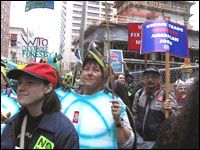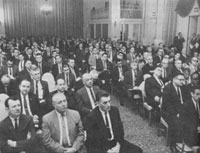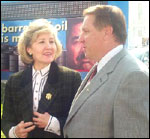The Washington, D.C., headquarters of the AFL-CIO, which represents 13 million workers in the United States, is on 16th Street just a couple of blocks north of the White House. On the morning of Sept. 11, some of the U.S. environmental movement’s most influential leaders — John Adams and Robert Kennedy, Jr., of the Natural Resources Defense Council, Carl Pope and Dan Becker of the Sierra Club, and John Podesta, a former White House chief of staff during the Clinton administration — were assembled in the federation’s executive conference room awaiting the arrival of its president, John Sweeney. Their purpose: to discuss an agreement on energy conservation and the Arctic National Wildlife Refuge that would unite two of the progressive movement’s most important constituencies and be approved in the Democrat-controlled Senate.

Labor and greenies march together in
Seattle in 1999.
Most participants were convinced that the meeting was evidence of a promising and increasingly close alliance between labor and environmentalists — an alliance that had been gaining momentum ever since the 1999 protests of the World Trade Organization meeting in Seattle. At the time of the meeting at the AFL-CIO headquarters, the political atmosphere seemed ripe for further collaboration between environmental and labor activists. The right had recently lost control of the Senate after Vermont Sen. Jim Jeffords left the Republican Party and became an Independent, in part because of disagreements with the White House about environmental and workplace safety issues. And President Bush’s approval ratings were sinking, in large measure because unions and environmental groups were raising public awareness about his views on those issues and on free trade.
But history is merciless. Sweeney entered the room a few minutes late, bearing the bad tidings about the terrorist attacks on New York City. Not long afterward, a column of smoke billowed up over the Potomac, blackening the air over the attack on the Pentagon. The group broke up, and with it an opportunity was lost.
Back to Ground Zero
The attacks of Sept. 11 significantly diminished the likelihood of a labor-environmental alliance becoming a major force in U.S. politics during the Bush administration. Operating as a joint force, the two movements had periodically achieved political triumphs in the past. In 1970, the Steelworkers of America joined environmental organizations to help design and gain congressional approval for the federal Clean Air Act. Three years later, environmental organizations helped the Oil, Chemical, and Atomic Workers Union wage a successful strike over health and safety issues at Shell refineries in four states. And in the 1980s, state environmental organizations built coalitions with union locals to pass legislation giving workers and the public the right to know what chemicals were in their factories and communities.

Steelworkers at a conference on air
pollution prior to passage of the Clean
Air Act.
Photo: Steelworkers of America.
In the 1990s, some environmental and labor leaders found common ground on free trade, global climate change, and energy issues. A number of new environmental-labor coalitions were born during the decade, including the Oregon-based Alliance for Sustainable Jobs and the Environment, the New Jersey Work Environment Council, and the Washington, D.C.-based Blue/Green Working Group. The Seattle protests more firmly cemented many partnerships between large national environmental groups such as Friends of the Earth and the Natural Resources Defense Council and prominent unions, including the Steelworkers, Service Employees International Union, Longshoremen, and others. After the protests, leaders of both movements said they anticipated a new era of cooperation to counter the influence of big business contributions in political campaigns and the rightward lurch in state legislatures and Congress.
But in recent months, the glue holding the alliance together has weakened. Although environmental activists are currently celebrating one of their most striking victories in years — the Senate vote to block drilling in the Arctic National Wildlife Refuge — they are also expressing disappointment at failing to unite the labor movement behind them. On Arctic drilling, and on an earlier battle this year to raise fuel-economy standards for cars and trucks, important unions broke with environmentalists and sided with corporate interests and the White House.
Environmental and labor leaders are quick to point to other facets of the blue-green relationship that remain strong, particularly their joint work on global climate change and free trade, but there is an unmistakable strain that both sides say they are anxious to repair. Leaders blame at least part of the schism between the movements on Bush’s chief political advisor, Karl Rove, who has apparently made it a priority to divide and conquer the blue-green collaboration.
Fuel on the Hill
The first important setback came on March 12, when the 720,000-member United Auto Workers Union sided with the Big Three Detroit automakers to effectively kill, 62-38, a Senate measure sponsored by John Kerry (D-Mass.) and John McCain (R-Ariz.) to increase fuel-economy standards for cars and light trucks.

Foreign vehicles put a dent in the
American auto industry.
Environmental leaders were appalled. The auto workers union has lost half its membership since the mid-1970s because of foreign competition and a relentless campaign by management to cut union jobs through plant closings, manufacturing outside the U.S., and technological improvements. Foreign manufacturers now account for 40 percent of all car and truck sales in the United States, more than ever before.
Moreover, a poll of 650 registered voters in Michigan conducted for the Sierra Club in January found that 84 percent of UAW households in that state favored increasing fuel-economy standards to 40 miles per gallon over the next 10 years — even for ultra-popular and notoriously gas-guzzling SUVs. (The current standards, which have been in place since 1975, are 27.5 miles per gallon for cars and 20.7 for light trucks and SUVs.) And previous polls in Michigan found that most UAW members agreed with environmentalists that higher fuel-economy standards would lead to American vehicles that were better able to compete with those made by foreign manufacturers.
Yet the UAW’s leadership backed the automakers and swayed the votes of Democratic senators who are generally sympathetic to environmental issues, including Carl Levin and Debbie Stabenow of Michigan.
“The UAW will end up suffering in the long-term,” said Dan Becker, the Sierra Club’s director of global warming and energy programs. “The Big Three will fail to compete with better vehicles and the Japanese will gain more market share.”
Paul Krell, the UAW’s communications director in Detroit, said the union backed management because it was convinced that the Kerry-McCain proposal to increase average fuel economy to 36 miles per gallon within 15 years would have cost thousands of union jobs. The UAW cited independent engineers who claim that redesigning engines, transmissions, and vehicle styles to meet the new standard would cost billions of dollars at a time when profits are slim and half of all sales are low-mileage pickups and sport utility vehicles. The union feared more closures of American car and truck plants.
“We met with various environmental groups on this issue,” said Krell, “and we didn’t get terribly far, unfortunately.”
Switching Teamsters
The divide that opened between environmental and labor activists over the Kerry-McCain proposal grew more pronounced during congressional debate over the president’s production-focused energy plan. “The Bush administration sees energy as a place to divide labor and environmentalists,” said Jim Jontz, a former Democratic member of Congress from Indiana who now coordinates the Alliance for Sustainable Jobs and the Environment, a nearly three-year-old coalition of green groups and unions based in Portland, Ore. “The White House recognized this as a wedge issue that will have long-term effects on a political alliance that they do not like.”

The prez courting Teamsters.
Photo: White House.
Although it did not ultimately pay off, that strategy was effective at dividing environmentalists and labor unions during the most heated battle of the Bush energy policy to date: the debate over drilling for oil and gas in the Arctic National Wildlife Refuge. On April 18, the Senate voted, 54 to 46, to block drilling in the refuge.
That vote came despite intensive lobbying by the White House and the 1.4 million-member Teamsters Union, which backed the president’s energy plan, a version of which passed the House last summer. According to Sen. Paul Wellstone (D-Minn.), the vote was the result of an extensive grassroots campaign organized by environmental organizations. The environmental position also received significant support from some unions, particularly the 600,000-member Steelworkers Union and the million-plus member Service Employees International Union, both of which opposed opening the Arctic Refuge to drilling. (The Steelworkers Union support was especially strong; even a last-minute attempt by Alaska’s two Republican senators, Frank Murkowski and Ted Stevens, to leverage its support by funneling public money to health and retirement benefits for steelworkers ultimately failed to sway the union.)
The Sierra Club’s Becker was convinced weeks before the vote that environmental groups — millions of members strong and growing — would prevail. But he acknowledged that the issue created a significant rift between labor and environmentalists. “It’s impossible to say that unions who are opposing environmental initiatives haven’t damaged the relationship that was building between us,” he said. “They have.”
Teamsters executives say they supported drilling in the refuge because it would stabilize fuel supplies and produce tens of thousands of jobs in Alaska and elsewhere. “There are 600,000 truck drivers that need an affordable source of fuel,” said Jerry Hood, the principal officer for the Teamster Local 959 in Alaska, who managed the union’s energy campaign in Washington, D.C. “We also represent building and construction employees. So we see this as a jobs bill, too, at a time when unemployment in Alaska is the highest in a decade.”

Teamsters head James Hoffa
buddies up with Sen. Kay Bailey
Hutchison (R-Texas).
Photo: U.S. Senate.
Environmental leaders disputed the Teamsters’ estimate of jobs and claim that what really drove the union was a pact with the White House. Although they couldn’t prove it, environmental leaders say they were convinced that, in exchange for the Teamsters support on the Bush energy plan and oil drilling in the Arctic, the White House promised union president James Hoffa that it would end the federal government’s oversight of the union, which began in 1989 to stem internal corruption.
One strong piece of evidence supporting that theory was a decision by the U.S. Attorney’s office in Manhattan to eliminate the independent financial auditor that was appointed by the Justice Department to oversee the union’s finances following an election scandal in 1996. U.S. District Judge Loretta Preska signed the order to end the auditor’s oversight on Dec. 20, 2001, thereby saving the union roughly $60,000 per month in auditing fees, according to public records. The Teamsters announced the decision on Jan. 10, 2002, exactly a week before President Bush visited the union’s Washington headquarters to promote the opening of the Arctic Refuge as a jobs bill.
“Many of us saw that court order as the overt act of what is otherwise an apparent conspiracy between Bush and the Teamsters to let the union out of federal receivership in return for political cover on the Arctic National Wildlife Refuge,” said Becker.
In response, the Teamsters’ Jerry Hood flatly denies any private agreement with the White House. “That is absolute hogwash,” he said. “There are no quid pro quos with the administration. Mr. Hoffa believes the only reason we become involved in an issue is if it helps the people we work for.”
Nevertheless, executives in other unions wince when they talk about the Teamsters involvement in the drilling debate. Public opinion polls consistently find that more than 60 percent of Americans oppose opening the Arctic Refuge to resource extraction. The polls also show that Americans understand that drilling in the wilderness would not fix the nation’s energy problems and believe the real solution lies in developing alternatives and using energy much more efficiently. The fact that one of the nation’s largest unions does not embrace that view hurts the entire labor movement, said union leaders.
“Political clout is based on membership,” said Rick Engler, a former member of the Oil, Chemical, and Atomic Workers Union who now directs the New Jersey Work Environment Council, a four-year-old group based in Lawrenceville, N.J., which represents 54 union, community, and environmental organizations. “How does the labor movement reclaim the terrain it’s lost by siding with the same companies that are laying people off right and left, downsizing, supporting trade agreements, opening shops overseas with low-paying jobs? Ultimately in the big picture it makes no sense.”
Lefties of the World, Unite!
The Senate vote relating to Kerry-McCain, the union-management partnership, and the divide over the nation’s energy policy have produced a profound sense of unease, not only among environmentalists, but also with rank-and-file workers and some industry observers. “It is understandable, that, with only self-interest in mind, proponents of automotive business-as-usual had reason to cheer,” said Automotive News, an influential weekly magazine that covers the industry, in an editorial on the fuel-economy vote in its March 22 edition. “But here is the underlying reality: The tough decisions on how best to reduce motor vehicle fuel consumption, limit U.S. dependence on imported oil, and protect the environment have only been put off until another time. And they will be much tougher to resolve later. That’s nothing to celebrate.”
Perhaps in recognition of that inevitability, both environmentalists and labor leaders say they are anxious to repair their fragile relationship. “Neither movement alone has the power to advance very far on most issues without the other,” said Engler. “It is in labor’s long-term interest to take environmental positions. If labor doesn’t organize it dies. Its ability to organize depends on public perception of what it stands for in society. It has to stand for clean air and water. And environmentalists have to do a better job of understanding labor. … If it were their jobs [on the line], they wouldn’t be so smug.”
“I have seen what can happen when interested trade unionists and environmentalists work together to establish common ground around these issues,” said Jane Perkins, a former business agent with the Service Employees International Union who later became president of Friends of the Earth in Washington, before returning to the labor movement as a consultant to the AFL-CIO on environmental issues. “It’s going to take a few more years before that effort translates into a piece of legislation. The relationship is not strong enough now.”
She continued, “When the discussion in this relationship gets to a place where people talk about how to take care of impacted workers, then everybody can be in favor of the best solutions for the environment.”

